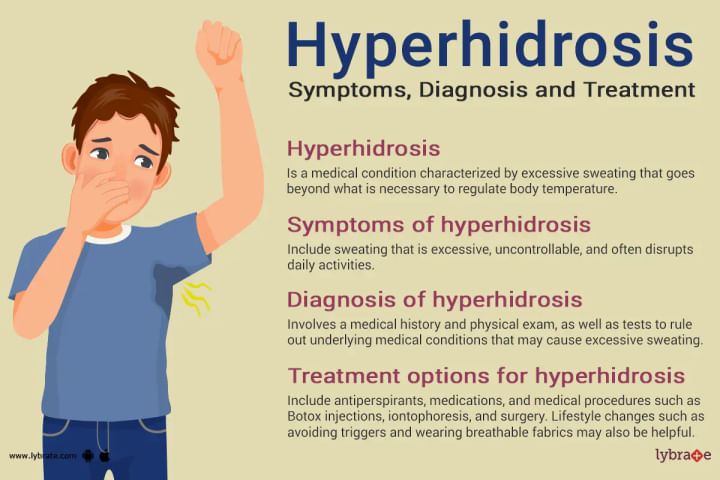Hyperhidrosis: Symptoms, Diagnosis and Treatment
Hyperhidrosis can be best defined as a medical condition or disorder in which a person sweats excessively, beyond what is considered normal for regulating body temperature. People with hyperhidrosis can experience excessive sweating in different areas of their bodies, including the palms of their hands, soles of their feet, underarms, face, and other regions. Excessive sweating can occur even when there are no triggers, such as physical activity or high temperatures, and can negatively impact daily activities and quality of life.
Hyperhidrosis may also result in emotional turmoil, causing low self-esteem, anxiety, and depression in some individuals. Excessive sweating can make it difficult to perform everyday tasks, such as holding a steering wheel, shaking hands, or even holding a pencil. This can negatively impact a person's work and social life, leading to significant emotional distress.
Hyperhidrosis is a common and treatable condition that often begins with the use of antiperspirants. If antiperspirants are not effective, various medications and therapies may be tried.
In severe cases, a medical expert may suggest surgical intervention to remove the sweat glands or to interrupt the nerves linked to excessive sweating. It is also possible that an underlying medical condition may be discovered and treated, contributing to the resolution of hyperhidrosis symptoms.
What are the symptoms of hyperhidrosis?
The primary and most noticeable symptom of hyperhidrosis is excessive sweating. However, there are other signs and symptoms that may be associated with this condition, including:
- Sweating that is not related to physical activity or heat
- Sweating that affects daily activities, such as holding objects, typing on a keyboard, or shaking hands
- Soaked clothing, even in air-conditioned environments
- Embarrassment and self-consciousness, leading to social withdrawal or avoiding certain activities
- Skin infections caused by constant dampness, such as fungal infections like athlete's foot
- Difficulty holding onto objects because of wet hands
What are the risk factors for hyperhidrosis?
Hyperhidrosis can affect people of all ages and genders, but there are some factors that may increase the risk of developing this condition, including:
- Family history: Hyperhidrosis can be hereditary, and if a family member has this condition, you may be more likely to develop it.
- Anxiety or stress: Anxiety and stress can trigger sweating, and excessive sweating can also cause anxiety and stress.
- Obesity: Individuals who are obese (or overweight) may be more likely to experience excessive sweating.
- Menopause: Women who are going through menopause may experience excessive sweating and hot flashes quite often.
- Certain medications: Some medications (or drugs), which include antidepressants and anticholinergics, can cause excessive sweating.
How is hyperhidrosis diagnosed?
The diagnosis of hyperhidrosis typically starts with a medical history and physical examination. The doctor will ask questions about the frequency and amount of sweating, as well as any other symptoms or conditions that may be contributing to the excessive sweating.
Next, the doctor may perform a sweat test, which involves using a special powder or ink to mark the areas of the skin that are producing excessive sweat. This allows the doctor to determine the severity of the hyperhidrosis and see if it is affecting specific areas of the body or is more widespread.
In some cases, further testing may be needed to rule out underlying medical conditions that may be causing the excessive sweating. This may include some nerve conduction studies, blood tests, or imaging tests such as MRIs or CT scans.
Differentiating between primary and secondary hyperhidrosis is also crucial for doctors to effectively diagnose the condition. Primary hyperhidrosis is a condition that is not caused by an underlying medical condition, while secondary hyperhidrosis is caused by a medical condition such as an overactive thyroid, menopause, or certain medications.
All things considered, the process of diagnosing hyperhidrosis typically involves several steps, starting with a thorough medical history and physical examination. The doctor may then conduct a sweat test to determine the severity of the excessive sweating.
Additional testing, such as blood tests or imaging, may also be necessary to rule out any underlying medical conditions that may be causing the hyperhidrosis. Importantly, the distinction between primary and secondary hyperhidrosis is vital for determining the most appropriate treatment plan. If you are experiencing excessive sweating, it is important to speak with your doctor to find a solution that works best for you.
How is hyperhidrosis caused?
Hyperhidrosis, or excessive sweating, is a condition where a person sweats more than is necessary for regulating body temperature. The exact cause of hyperhidrosis is not fully understood, but there are several factors that are thought to contribute to its development.
Hyperhidrosis frequently stems from genetics, as evidenced by its occurrence in families. Another potential cause of hyperhidrosis is an overactive nervous system. The sympathetic nervous system controls the sweat glands, and when it is overactive, it can result in excessive sweating.
Hyperhidrosis can sometimes result from a medical issue or medication side effect, such as an overactive thyroid, menopause, or an autoimmune disease. Certain medications, such as antidepressants and anticholinergics, can also cause excessive sweating.
Stress and anxiety can also trigger hyperhidrosis, as the body’s 'fight or flight' response releases chemicals that can cause the sweat glands to become overactive. Lastly, obesity and a poor diet can contribute to hyperhidrosis as the body works harder to regulate its temperature.
All in all, hyperhidrosis is a complex condition that can be caused by a combination of factors, including genetics, an overactive nervous system, underlying medical conditions, medications, stress and anxiety, and lifestyle factors such as obesity and diet. Therefore, seeking medical advice is crucial for individuals facing excessive sweating in order to identify the root cause and find effective treatment methods.
How is hyperhidrosis treated?
The method of managing hyperhidrosis predominantly depends on the intensity of the condition and what is causing it. Some common methods include antiperspirants, iontophoresis, prescription antiperspirants, Botox injections, and surgery.
Lifestyle changes such as wearing breathable clothing and avoiding triggers that cause sweating can also help. In severe cases, medications like anticholinergics and anticonvulsants may be prescribed. Consulting a physician or other healthcare professionals is crucial to determining the optimal treatment plan for your unique situation.
Conclusion
Hyperhidrosis is, in short, a medical condition or disorder in which a person sweats excessively. If you feel you are suffering from hyperhidrosis, it is important you visit your physician and ask for some treatment options. Treating hyperhidrosis is important because it can have a negative impact on a person's social life and self-confidence. With treatment, hyperhidrosis is a manageable condition, so you should never feel like you are alone in dealing with this condition.



+1.svg)
